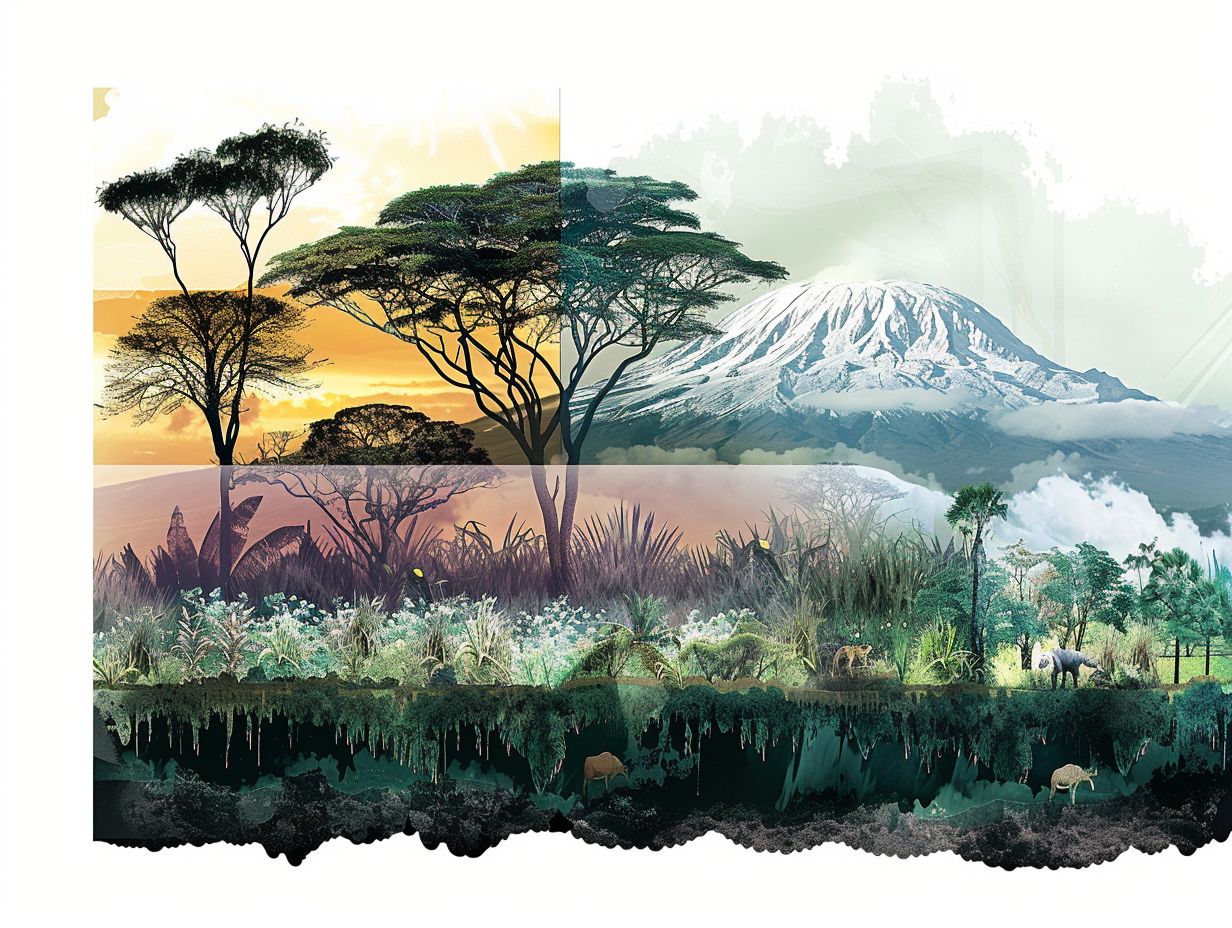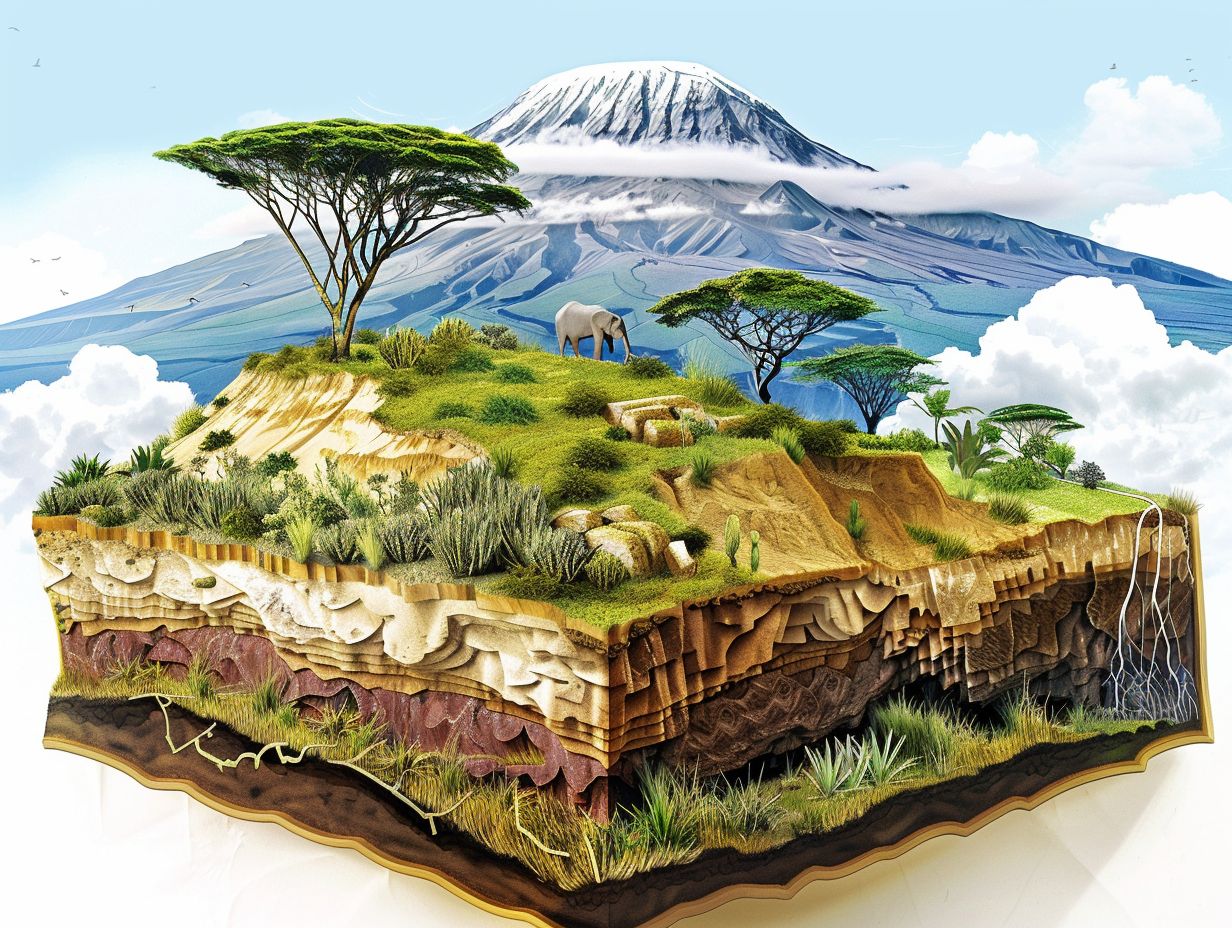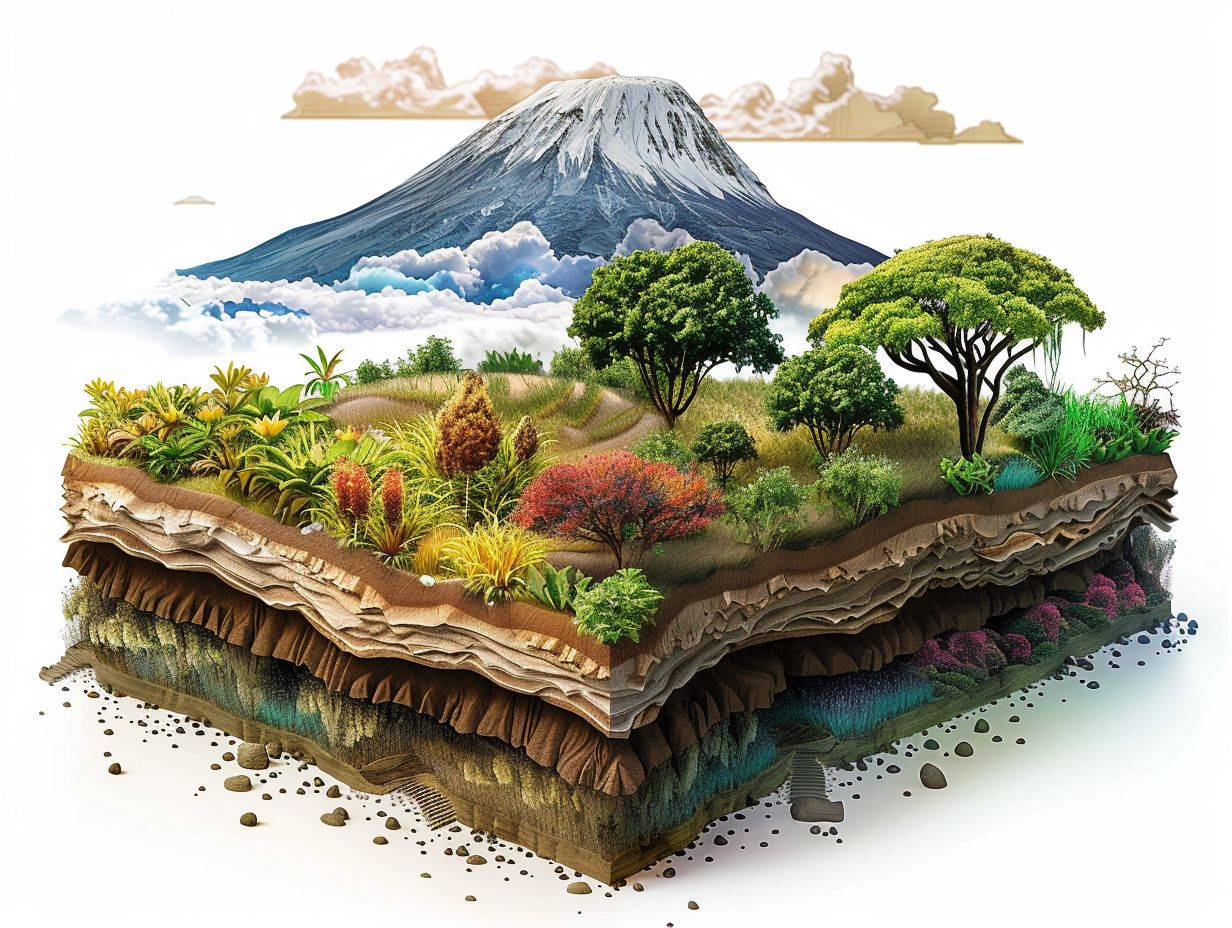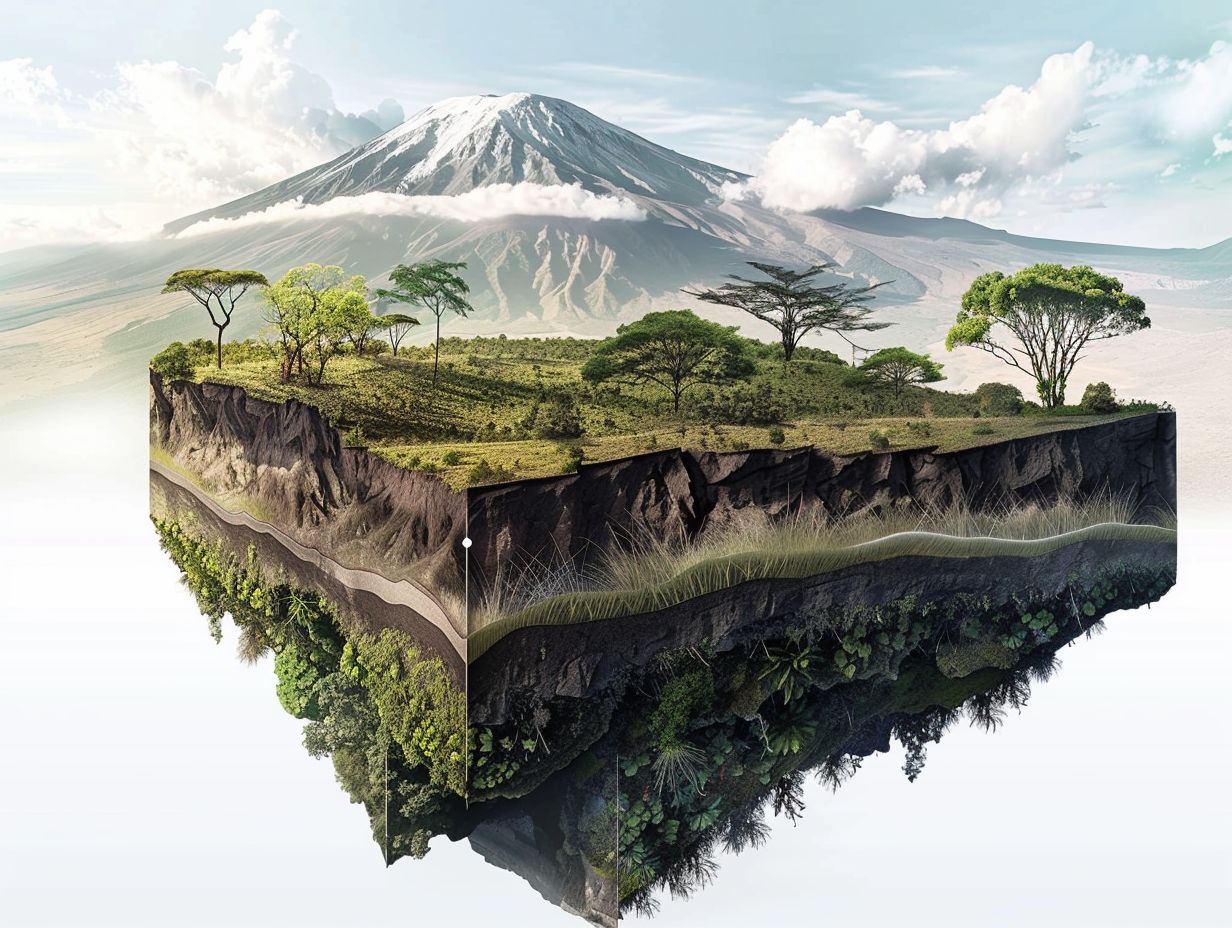
Kilimanjaro Climate Zones
Have you ever wondered about the diverse climate zones of Mount Kilimanjaro?
From the lush rainforests to the barren Arctic zone, each zone presents its own set of challenges and characteristics for climbers.
In this article, we will explore the cultivation, rainforest, heath and moorland, alpine desert, and arctic zones of Kilimanjaro.
We will also discuss the best time to climb the mountain and the unique challenges climbers face in each climate zone.
Get ready to embark on a journey through the remarkable landscapes of Kilimanjaro!
Key Takeaways:

- The climate zones of Kilimanjaro offer a diverse range of landscapes and weather conditions, each with its own unique characteristics and challenges.
- The best time to climb Kilimanjaro is during the dry season from June to October, but the wet season from November to May offers a different experience for more adventurous climbers.
- Climbing Kilimanjaro requires preparation and adaptation to the varying climate zones, from the lush rainforest to the barren arctic zone.
What are the Climate Zones of Kilimanjaro?
Kilimanjaro boasts several distinct climate zones dictated by altitude variations, ranging from lush rainforests to barren Arctic landscapes due to its impressive height and ecological diversity.
As one ascends the slopes of Kilimanjaro, the temperature steadily drops, leading to a gradual transformation in vegetation and terrain. The first zone encountered is the lush montane forest, characterized by moss-covered trees and a rich diversity of plant species such as towering ferns and giant lobelias.
At higher altitudes, the forest gives way to the moorland zone, where the landscape becomes more open, dotted with heather and tussock grasses adapted to the cooler temperatures. Subalpine conditions emerge further up, marked by alpine desert environments that are stark and devoid of much vegetation.
-
Cultivation Zone:
The cultivation zone on Kilimanjaro is characterized by rich volcanic soil, ideal for agricultural practices that support the growth of crops and vegetation vital for local communities.
Due to the volcanic nature of the soil, it boasts exceptional fertility, providing optimal conditions for a wide variety of crops to thrive. Farmers in the region benefit greatly from this fertile land, cultivating staples like maize, beans, and coffee, which play a significant role in sustaining the local economy.
The diverse plant life in the area contributes to the rich ecosystem, with lush vegetation attracting a plethora of wildlife. This biodiverse environment not only supports agriculture but also acts as a habitat for various species, fostering a delicate balance between cultivation and conservation.
-
Rainforest Zone:
The rainforest zone of Kilimanjaro is a verdant paradise teeming with diverse flora and fauna, including towering trees, lush vegetation, and a myriad of animal species that thrive in its tropical conditions.
One of the remarkable aspects of this ecosystem is the abundance of epiphytes that decorate the canopy, creating a mesmerizing display of colors and textures. These plants, such as orchids and bromeliads, thrive by clinging to branches and trunks, showcasing nature’s ingenious adaptations. The rich soil nurtures a tapestry of plant life, ranging from towering emergent trees to delicate ferns and striking lianas that intertwine and create a lively green tapestry.
The rainforest’s lush vegetation acts as a haven for diverse wildlife, with rare species like the colobus monkey swinging effortlessly among the branches, while vibrant birds like the African green broadbill add splashes of color to the vibrant green backdrop. The ecosystem’s dynamic interplay of flora and fauna paints a picture of biodiversity and interconnectedness that is both fascinating and essential for the overall health of this unique environment.
-
Heath and Moorland Zone:
The heath and moorland zone of Kilimanjaro is a transitional belt marked by unique plant species like Senecios and groundsels, along with wildlife such as speckled mousebirds and tropical boubou.
This ecological zone, situated between the montane forest and alpine desert, boasts a mix of low shrubs, lichens, and mosses that thrive in the thin, rocky soil at altitudes ranging between 2,500 to 4,000 meters.
The Senecios and groundsels play a crucial role in creating a surreal, alien-like landscape captured in many travelers’ photographs. Creatures like the endemic Kilimanjaro tree hyrax and the elusive mountain leopard call this region home, adapting to the harsh climate and rugged terrain.
-
Alpine Desert Zone:

The alpine desert zone of Kilimanjaro is a stark landscape defined by volcanic rocks, sparse vegetation such as Giant Lobelias, and hardy flora like lichens that can withstand the harsh conditions at higher altitudes.
Being above the treeline, this unique ecosystem is home to remarkable adaptive species that have evolved to thrive in the extreme conditions of high-altitude environments.
Endemic to such harsh landscapes are resilient plants like the Adenium Kilimanjaricum, known for its ability to store water in its succulent stems to survive long periods of drought. The volcanic terrain of Kilimanjaro contributes to the stark beauty of the alpine desert, with its rugged slopes and dramatic rock formations carved by ancient geological processes.
-
Arctic Zone:
The Arctic zone of Kilimanjaro is the pinnacle of its climatic diversity, featuring glaciers, snow-covered expanses, and the breathtaking Arctic summit that crowns the mountain in a frozen spectacle.
These frozen landscapes not only mesmerize the onlookers with their enchanting beauty but also present a formidable challenge to adventurers attempting to conquer the icy terrains.
The glaciers cling steadfastly to the mountain’s slopes, glistening in the sunlight, while the snowfields create a vast white canvas that stretches as far as the eye can see. The Arctic summit, with its frosty crown, stands as a testament to the harsh yet stunning environment of the Kilimanjaro Arctic zone.
What are the Characteristics of Each Climate Zone?
Each climate zone on Kilimanjaro offers a unique tapestry of vegetation, temperature variations, and microclimates that shape the diverse ecosystems found along the mountain’s ascent.
Starting from the lush rainforest zone at the base of the mountain, characterized by dense tree canopies and high humidity, hikers are greeted with a verdant landscape filled with towering trees and vibrant wildlife. As the altitude increases, the montane forest zone takes over, with smaller trees, moss-covered rocks, and a cooler, misty environment.
Transitioning into the heather and moorland zone, the landscape transforms into open grasslands dotted with shrubs and unique plants adapted to the harsh conditions.
The alpine desert zone, with its rocky terrain and sparse vegetation, marks a stark contrast to the lower zones. The arctic summit zone, where glaciers and ice fields dominate the landscape, showcases the harsh and unforgiving conditions at the peak of Kilimanjaro.
-
Cultivation Zone:
The cultivation zone is the lowermost region on Kilimanjaro, favored for agriculture due to its fertile soil, supporting local farming communities with crops and sustenance.
The fertile soil in this cultivation zone plays a key role in sustaining a variety of crops, including maize, coffee, and bananas, which are integral to the local economy.
The agricultural significance of this area lies in its unique climate conditions, with the right balance of rainfall and sunlight that promote healthy crop growth throughout the year.
Farmers in this region employ sustainable farming practices such as crop rotation, terracing, and organic fertilization to ensure long-term soil fertility and crop yields.
-
Rainforest Zone:
The rainforest zone is a biodiversity hotspot on Kilimanjaro, characterized by dense vegetation, towering trees, and a rich ecosystem that supports a wide array of plant and animal life.
This lush habitat is home to numerous species of plants, from towering canopy trees to delicate orchids that thrive in the humid environment. The diverse flora in the rainforest zone not only provides a picturesque scenery but also plays a crucial role in maintaining the ecological balance of the region. A variety of endemic and unique plant species can be found here, contributing to the overall species diversity of the area.
-
Heath and Moorland Zone:
The heath and moorland zone transitions into an alpine environment on Kilimanjaro, marked by unique plant adaptations and animal species that thrive in the challenging altitudes of this zone.
In the heath and moorland zone, low-growing shrubs and hardy grasses dominate the landscape, showcasing adaptations to the harsh mountain conditions. These plants often have thick cuticles to minimize water loss and deep root systems to access moisture in the thin, rocky soils.
As the altitude increases into the alpine zone, the vegetation becomes sparse, with lichens and mosses clinging to rocks. Animals like chamois and mountain goats have evolved thick fur and specialized hooves to navigate the steep terrain and find food sources.
-
Alpine Desert Zone:
The alpine desert zone of Kilimanjaro is a rocky expanse where hardy flora like Giant Lobelias thrive, adapting to the intense solar radiation and challenging conditions of this high-altitude environment.
Volcanic rocks, remnants of past eruptions, dot the landscape, contributing to the unique nature of this desert-like terrain. The solar exposure in this region is unparalleled, fostering the growth of specialized plants that have evolved remarkable strategies to survive in such harsh sunlight.
The flora here, including Senecios and Groundsels, have developed extensive root systems to absorb scarce moisture and minimize water loss. These specialized adaptations enable them to flourish in this arid environment, creating a striking contrast against the backdrop of rugged volcanic outcrops.
-
Arctic Zone:

The Arctic zone at the summit of Kilimanjaro is a frozen wonderland featuring glaciers, the iconic Arctic summit, and microclimates that defy the equatorial setting of the mountain.
These icy landscapes stand in stark contrast to the usual tropical climate found at lower elevations on the mountain. The glaciers serve as a reminder of the climatic challenges faced by those venturing into this frozen realm.
The Arctic summit, a point of convergence for extreme weather patterns, offers an unparalleled experience for adventurers seeking the ultimate test of endurance and willpower. Amidst these frozen expanses, unique microclimates create pockets of unexpected life, showcasing nature’s resilience even in the most inhospitable environments.
What is the Best Time to Climb Kilimanjaro?
The best time to climb Kilimanjaro is during the dry season from June to October when clear skies and stable weather conditions increase summit success rates for climbers.
During this optimal climbing window, climbers can expect favorable temperatures ranging from around 20°C to -7°C at the summit, providing a more comfortable ascent compared to the extreme cold experienced during the wet season. The dry conditions also reduce the likelihood of encountering rain and snow, making the trekking paths less slippery and hazardous.
The clear skies prevalent during this period offer breathtaking panoramic views of the surrounding landscape, including the stunning glaciers that adorn the mountaintop. It is essential to be prepared for rapid weather changes, especially as altitude increases, where temperatures can drop suddenly, necessitating adequate clothing and gear to combat these fluctuations.
-
Dry Season (June – October):
The dry season on Kilimanjaro, spanning from June to October, offers climbers favorable weather conditions with minimal precipitation, clear skies, and relatively stable temperatures conducive to summit attempts.
During this period, the lack of rainfall minimizes the risk of slippery, muddy trails, providing better traction for hikers. The clear skies not only offer breathtaking views of the surrounding landscapes but also increase the chances of seeing the stunning sunrise from the summit.
The relatively stable temperatures help climbers acclimatize more effectively, reducing the likelihood of altitude sickness and increasing the chances of a successful summit bid. The dry season on Kilimanjaro truly creates an ideal environment for those aiming to conquer its majestic peak.
-
Wet Season (November – May):
The wet season on Kilimanjaro, from November to May, presents climbers with challenges due to increased precipitation, cloud cover, and variable weather conditions that can impact visibility and summit attempts.
Climbers during the wet season often encounter slippery and treacherous paths, making the ascent even more demanding. Rainfall not only saturates the ground, creating muddy and slippery surfaces, but it also adds weight to gear, making the journey physically taxing. Cloud cover exacerbates navigation difficulties, with whiteout conditions more common, diminishing contrast on the landscape and blurring trail markers.
What Are the Challenges of Climbing Kilimanjaro in Each Climate Zone?
Climbing Kilimanjaro presents unique challenges in each climate zone, from altitude-related issues such as air pressure changes to temperature variations that test climbers’ endurance and acclimatization abilities.
Altitude-related difficulties pose physical and mental hurdles for climbers as they ascend through the different zones, encountering reduced oxygen levels that can lead to symptoms of altitude sickness such as headaches, nausea, and dizziness. The changing air pressure adds another layer of complexity, affecting breathing patterns and overall performance.
The drastic temperature shifts between zones demand careful preparation and gear adjustments to navigate the transition from scorching heat to freezing cold. These factors combine to create a formidable and dynamic environment that challenges even the most experienced adventurers.
-
Cultivation Zone:
The cultivation zone of Kilimanjaro poses challenges to climbers due to human activity, altered soil conditions, and the transition from agricultural lands to natural habitats as altitude increases along the ascent.
Human impacts in the cultivation zone create significant hurdles for the ecosystem’s balance, as deforestation, waste accumulation, and resource extraction have reshaped the landscape.
These activities lead to erosion, decreased water quality, and loss of biodiversity, further intensifying the challenges for both flora and fauna. The altered soil conditions, influenced by agrochemicals and extensive farming practices, disrupt the natural nutrient cycling and may result in long-term degradation of the ecosystem.
As climbers ascend through the zone, they witness a marked shift from cultivated areas to untouched wilderness, prompting contemplation on the delicate boundary between human intervention and pristine nature. The transition from agricultural lands to the untouched wilderness brings about a stark contrast in vegetation, wildlife presence, and overall environmental ambiance, highlighting the encompassing impact of human activities on the region.
-
Rainforest Zone:
The rainforest zone of Kilimanjaro presents challenges to climbers through dense vegetation, diverse animal life, and the biodiversity that thrives in these lush environments, creating hurdles for ascent and visibility.
As climbers venture into this verdant realm, they find themselves surrounded by towering trees, thick undergrowth, and tangled vines that impede their progress. The lush vegetation not only obscures the path but also provides a habitat for various creatures, from chattering monkeys to colorful birds, adding a sense of wonder and danger to the journey.
Navigating through this green maze requires agility and caution to avoid disturbing the delicate balance of the ecosystem. Every step taken must be deliberate, mindful of the hidden life forms that call this wooded sanctuary their home.
-
Heath and Moorland Zone:

The heath and moorland zone of Kilimanjaro challenges climbers with altitude gains, unique flora like Giant Lobelias, and fauna encounters, testing their adaptation to higher elevations and changing landscapes.
As climbers ascend through this zone, they must cope with reduced oxygen levels, making altitude adjustments crucial for their well-being. The dizzying heights pose challenges not only to humans but also to the diverse plant life that thrives here. The striking contrast between the delicate Giant Lobelias and rugged rocky terrain creates a surreal atmosphere.
Sightings of elusive animals like mountain reedbuck or various bird species offer a glimpse into the rich biodiversity of this region. Navigating through this ecological transition requires a keen eye and a deep appreciation for nature’s resilience.
-
Alpine Desert Zone:
The alpine desert zone of Kilimanjaro tests climbers with temperature extremes, intense solar radiation, and encounters with glaciers, creating physical and mental challenges as they traverse this rocky expanse.
Temperatures in the alpine desert zone can swing dramatically throughout the day, ranging from scorching heat under the glaring sun to biting cold during the night. These fluctuations demand climbers to be equipped with proper gear that can handle such extremities. The relentless solar exposure can quickly dehydrate climbers, requiring constant vigilance to stay hydrated and protect their skin. Glaciers, though stunning, pose another obstacle as climbers navigate around crevasses and slippery ice patches, adding a layer of complexity to an already demanding ascent.
-
Arctic Zone:
The Arctic zone at the summit of Kilimanjaro challenges climbers with icy conditions, frozen landscapes, and wildlife sightings, creating a surreal environment that tests their physical and mental resilience at the mountain’s peak.
Climbers face a myriad of challenges while navigating through the Arctic terrain. The harsh cold exposure can lead to frostbite and hypothermia, making it essential for climbers to be equipped with proper gear and clothing to combat the extreme temperatures.
The unpredictable weather conditions at the Arctic summit further add to the complexities, with sudden blizzards and whiteouts posing significant risks to climbers’ safety and navigation.
The diverse wildlife population in the region presents both awe-inspiring moments and potential hazards, requiring climbers to be vigilant and respectful of the natural habitat to ensure a successful summit attempt.
Frequently Asked Questions:
1. What are the different climate zones on Kilimanjaro?
A: Kilimanjaro has five main climate zones, ranging from the warm savannah at the base to the Arctic conditions at the summit. These zones include the Cultivation Zone, Rainforest Zone, Heather-Moorland Zone, Alpine Desert Zone, and the Arctic Zone.
2. What is the Cultivation Zone on Kilimanjaro?
A: The Cultivation Zone is the lowest climate zone on Kilimanjaro, located at the base of the mountain. It is known for its warm and humid conditions, making it ideal for agriculture and farming.
3. What is the Rainforest Zone on Kilimanjaro?
A: The Rainforest Zone is the second climate zone on Kilimanjaro and is characterized by dense and lush vegetation filled with a variety of plant and animal species. This zone is known for its high levels of precipitation and humidity.
4. What is the Heather-Moorland Zone on Kilimanjaro?
A: The Heather-Moorland Zone is the third climate zone on Kilimanjaro, located above the Rainforest Zone. This zone is known for its heather and moorland vegetation, as well as its cooler temperatures and strong winds.
5. What is the Alpine Desert Zone on Kilimanjaro?
A: The Alpine Desert Zone is the fourth climate zone on Kilimanjaro, characterized by dry and rocky terrain with sparse vegetation. This zone is known for its extreme temperature changes, with hot days and freezing nights.
6. What is the Arctic Zone on Kilimanjaro?
A: The Arctic Zone is the final climate zone on Kilimanjaro, located at the summit of the mountain. This zone is characterized by freezing temperatures, strong winds, and little to no vegetation. It is important for climbers to prepare for these harsh conditions before attempting the summit.